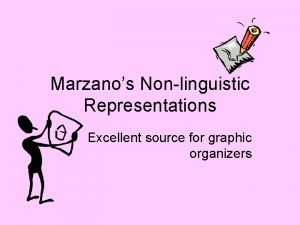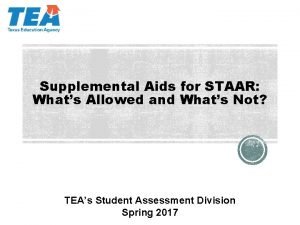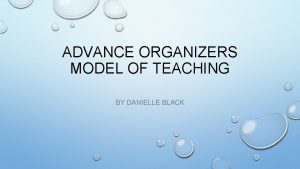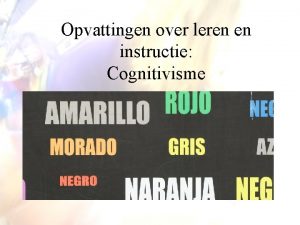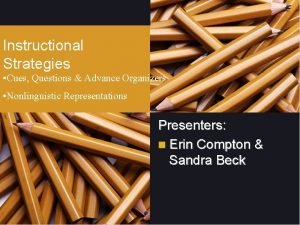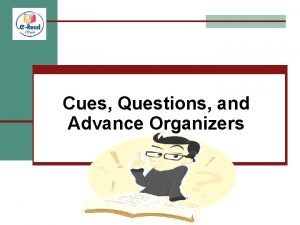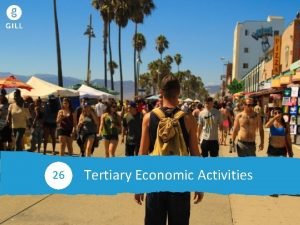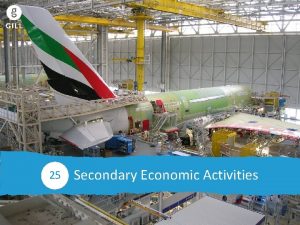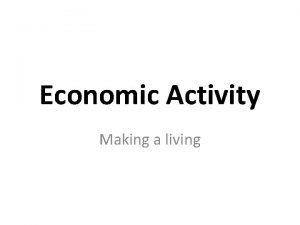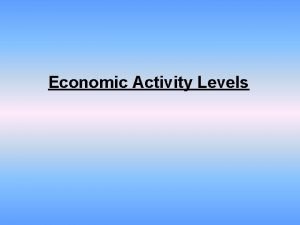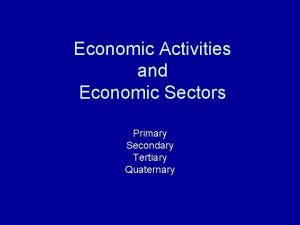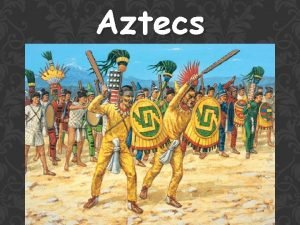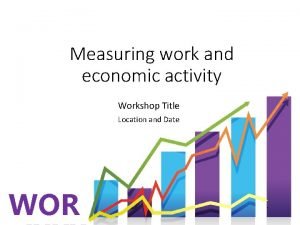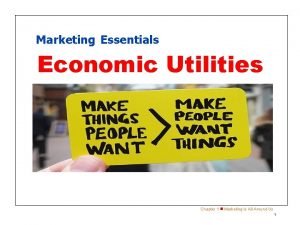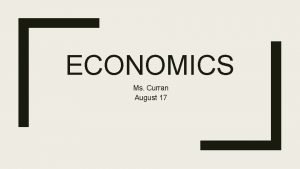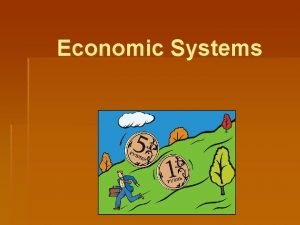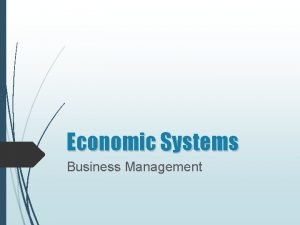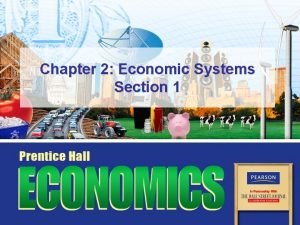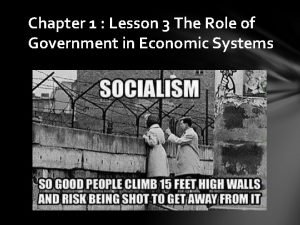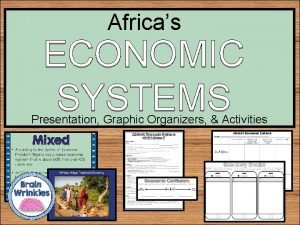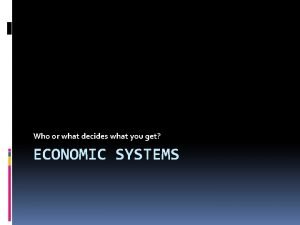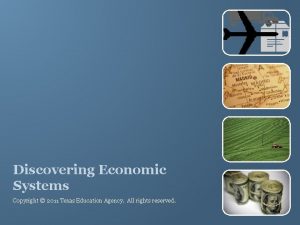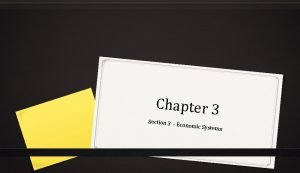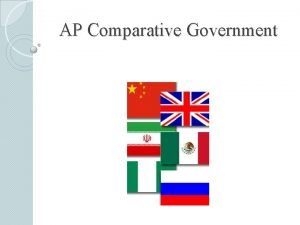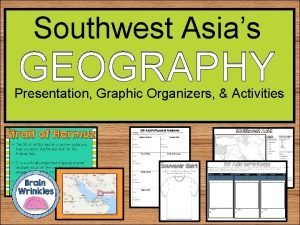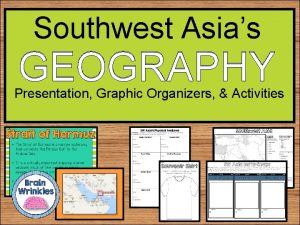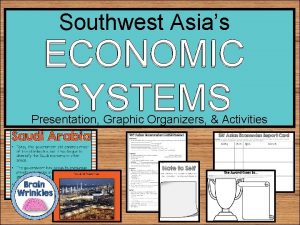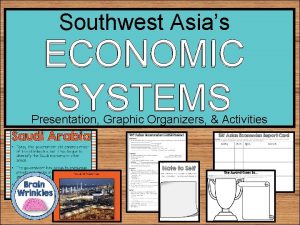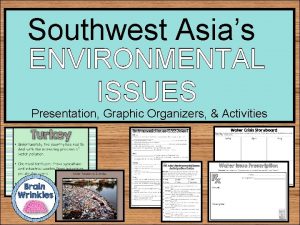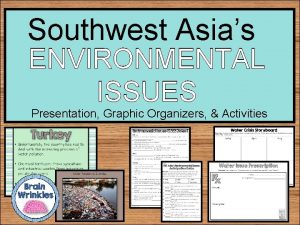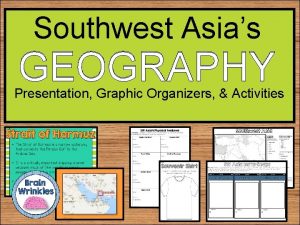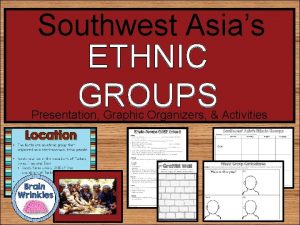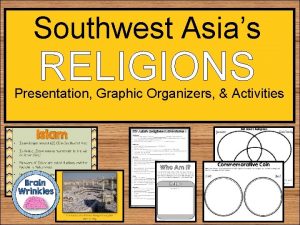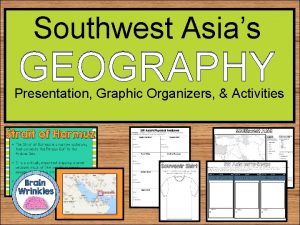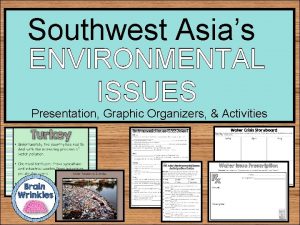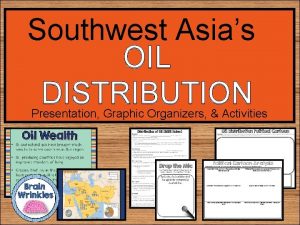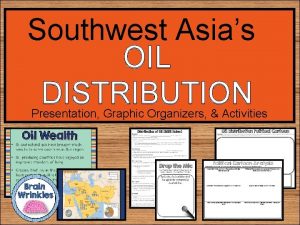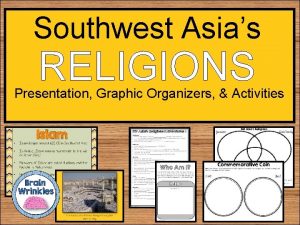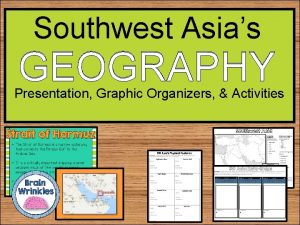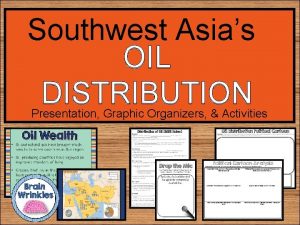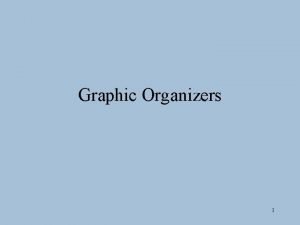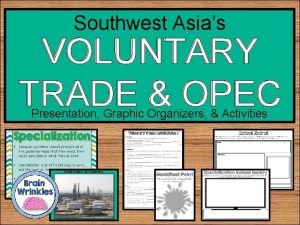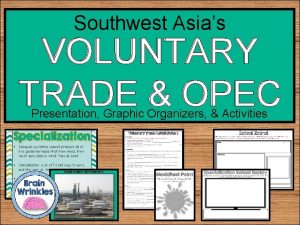Southwest Asias ECONOMIC SYSTEMS Presentation Graphic Organizers Activities























































- Slides: 55

Southwest Asia’s ECONOMIC SYSTEMS Presentation, Graphic Organizers, & Activities

STANDARDS: SS 7 E 4 Analyze different economic systems. a. Compare how traditional, command, and market economies answer the economic questions of 1 -what to produce, 2 -how to produce, and 3 -for whom to produce. b. Explain that countries have a mixed economic system located on a continuum between pure market and pure command. c. Compare and contrast the economic systems in Israel, Saudi Arabia, and Turkey. © Brain Wrinkles

TEACHER INFO: CLOZE Notes • The next pages are handouts for the students to use for note-taking during the presentation. (Print front to back to save paper and ink. ) • Check the answers as a class after the presentation. © Brain Wrinkles

SW Asian Economies CLOZE Notes 1 Let’s Review • Do you remember the three questions that every country must answer when developing its _____________ ? _____________ will be produced? __________________________ the goods/services? The way a country answers these questions determines what _____________ it will have: Traditional, Command, Market • • Traditional • All economic decisions are based on customs, _______ , & beliefs of the past. • People will make what _____________ and do the same things their parents did. • The exchange of goods is done through _______. • Bartering = trading _____________ • Some examples: villages in Africa & South America, the Inuit in Canada, _____________ Command • All economic decisions are made by the _______. • The government owns most of the property, _____________ , determines the wages of workers, plans what will be made…everything. • This system has _____________. More and more countries are abandoning it. • This system is _____________ ; because of this, there are no PURE command countries in the world today. • Some countries are close: Cuba, _____________ , North Korea, former East Germany, etc. • All of these countries have the same type of government: _______ ! The government is in control of everything. Market • Economic decisions are made based on the _____________ that occur as buyers & sellers interact in the market place. • The government has _____________ ; private citizens answer all economic questions. • In a truly free market economy, the government would _____________ at all. Scary… • There would be no laws to make sure _____________. *Food! Medicine! • There would be no laws to _____________ from unfair bosses. • Because of this, there are _____________ , but some countries are closer than others. © Brain Wrinkles

SW Asian Economies CLOZE Notes 2 Hmmm… • Since there are _______ that are purely command or purely market, what does that make them? • Most democratic countries have some _____________ , so we keep it simple and call them: _______. • Of course, most countries’ economies are _____________ of system than another. Israel • Israel has a _____________. • According to the Index of Economic Freedom, Israel is _____________ and 30% command. • Private businesses in technology, agriculture, and tourism, determine their _____________ of goods and services. • Prices are based on _____________. • While private enterprise plays a role in Israel’s economy, the government also has a hand in the country’s _____________. • The government controls the electric, natural gas, and aerospace industries, and most of the _____________. • It charges various taxes and controls prices on agricultural goods and _____________. • Israel has the _____________ economy in Southwest Asia. • Its important industries include: mining, cutting and polishing diamonds, agriculture, & manufacturing _____________. Also, a high percentage of Israelis work in the _____________ , as Israel is a popular tourist destination. • 1. What to Produce? Individuals and corporations; government has _____________ 2. How to Produce? _____________ ; government has some regulations 3. For Whom to Produce? Individuals and corporations; _____________ regulations Challenges • Since its creation in 1948, Israel has been involved in much _____________. • Building up its _____________ and maintaining its armed forces has put a strain on Israel’s economy. • Another financial burden has been large _____________ , even though they have brought valuable skills to the country. © Brain Wrinkles

SW Asian Economies CLOZE Notes 3 SAUDI ARABIA Past • In 1932, when Saudi Arabia became a nation, its economy was _____________ and consisted of trading camels, goats, & textiles. • When _____________ , the Saudi royal family transformed the economy into _____________ and profited greatly from oil wealth. Present • Today, the government still controls most of the _____________ , but it has begun to diversify the Saudi economy in other areas. • The government has begun to encourage private enterprise in areas like power generation and _____________. . • With a large part of revenue now coming from private businesses, Saudi Arabia now has a _____________ that rates as 64% free and 36% command. • The government is trying to grow the private sector in order to _____________. • Private businesses are being asked to take on a _____________ in education, healthcare, and tourism. • The Saudi government has even started _____________ of the country’s petroleum company to the public. • Despite the recent changes, the Saudi government is still _____________ in the country’s economy. • It lets private companies _____________ about production and prices. Saudi Arabia 1. What to Produce? _____________ ; government has many restrictions on the oil industry 2. How to Produce? Individuals and corporations; government has many restrictions on _____________ 3. For Whom to Produce? Individuals and corporations; government has _____________ on the oil industry Challenges • Income from oil _____________ of the country’s budget; however, oil supplies _____________. • Saudi Arabia’s _____________ is high. • One-third of Saudi Arabia’s jobs are filled by people from other countries because the country has a shortage of _____________. © Brain Wrinkles

SW Asian Economies CLOZE Notes 4 TURKEY Past • When Turkey became a country in 1923, its ruler Mustafa Kemal set up a _____________. • Kemal believed the government should _____________ the economy, so he invested in the _____________ : dams, electricity, ports, railroads, and roads. The government also developed important _____________. • Present • Reforms in Turkey since the 1980 s have moved it to a _____________. • Today, Turkey is by far the _____________ in the Middle East, and it rates as 65% free and 35% command. • The Turkish government has aggressively privatized state-owned industries in recent years and _____________ in agriculture, electronics, textiles, automotive, and petrochemicals. • Private companies are able to decide how much to produce and to _____________ based on supply and demand. Much of Turkey’s land, businesses, and factories are _____________. • Turkey • The state still has an active role in Turkey’s economy; it plays a _____________ , communication, banking, and transportation. • It charges taxes on businesses and some of its regulations are difficult to comply with, which has led to an increase in _____________. The government _____________ on electricity and some food items. • 1. 2. 3. What to Produce? _____________ ; government has some regulations on industry, banking, transportation, & communications How to Produce? Individuals and corporations; government _____________ on industry, banking, transportation, & communications For Whom to Produce? Individuals and corporations; government has some regulations on industry, banking, _____________ , & communications Challenges • Turkey lies _____________ and partly in Asia. • Because most of Turkey’s trade is with Western Europe, so it has been trying for years to _____________. Unfortunately, Turkey is considered a _____________ and remains poor when compared to most European countries. • © Brain Wrinkles

Southwest Asia’s Economic Systems Israel, Saudi Arabia, & Turkey © Brain Wrinkles

Let’s Review • Do you remember the three questions that every country must answer when developing its economic plan? 1. What goods/services will be produced? 2. How will goods/services be produced? 3. Who will consume the goods/services? • The way a country answers these questions determines what kind of economic system it will have: Traditional Command Market

Traditional • All economic decisions are based on customs, traditions, & beliefs of the past. • People will make what they always made and do the same things their parents did. • The exchange of goods is done through bartering. • Bartering = trading without using money • Some examples: villages in Africa & Asia, the Inuit in Canada, Aborigines in Australia

Afghan Village Traditional Economy

Command • All economic decisions are made by the Government. • The government owns most of the property, sets the prices of goods, determines the wages of workers, plans what will be made…everything. • This system has not been very successful. More and more countries are abandoning it.

Command • This system is very harsh to live under; because of this, there are no PURE command countries in the world today. • Some countries are close: Cuba, former Soviet Union, North Korea, former East Germany, etc. • All of these countries have the same type of government: Communist! The government is in control of everything.

North Korea’s Command Economy

Market • Economic decisions are made based on the changes in prices that occur as buyers & sellers interact in the market place. • The government has no control over the economy; private citizens answer all economic questions. • In a truly free market economy, the government would not be involved at all. Scary… • There would be no laws to make sure goods/services were safe. *Food! Medicine! • There would be no laws to protect workers from unfair bosses. • Because of this, there are no PURE market economies, but some countries are closer than others.

2016 Index of Economic Freedom

Hmmm… • Since there are no countries that are purely command or purely market, what does that make them? • Most democratic countries have some characteristics of both systems, so we keep it simple and call them: MIXED. • Of course, most countries’ economies are closer to one type of system than another.

ISRAEL © Brain Wrinkles

Israel • Israel has a mixed economic system. • According to the Index of Economic Freedom, Israel is 70% free and 30% command. • Private businesses in technology, agriculture, and tourism, determine their own production of goods and services. • Prices are based on supply and demand.

Israel • While private enterprise plays a role in Israel’s economy, the government also has a hand in the country’s economic planning. • The government controls the electric, natural gas, and aerospace industries, and most of the land is governmentowned. • It charges various taxes and controls prices on agricultural goods and banking services.


Israel • Israel has the most diversified economy in Southwest Asia. • Its important industries include: mining, cutting and polishing diamonds, agriculture, & manufacturing tech equipment. • Also, a high percentage of Israelis work in the service industry, as Israel is a popular tourist destination.

Israel’s Tourist Destinations: Tel Aviv Jerusalem

Israel 1. What to Produce? Individuals and corporations; government has some regulations 2. How to Produce? Individuals and corporations; government has some regulations 3. For Whom to Produce? Individuals and corporations; government has some regulations

Challenges • Since its creation in 1948, Israel has been involved in much conflict with its neighbors. • Building up its national security and maintaining its armed forces has put a strain on Israel’s economy. • Another financial burden has been large volumes of immigrants, even though they have brought valuable skills to the country.


SAUDI ARABIA © Brain Wrinkles

Past • In 1932, when Saudi Arabia became a nation, its economy was mostly traditional and consisted of trading camels, goats, & textiles. • When oil was discovered, the Saudi royal family transformed the economy into mostly command profited greatly from oil wealth.


Present • Today, the government still controls most of the oil industry, but it has begun to diversify the Saudi economy in other areas. • The government has begun to encourage private enterprise in areas like power generation and natural gas exploration. • With a large part of revenue now coming from private businesses, Saudi Arabia now has a mixed economy that rates as 64% free and 36% command.

Saudi Arabia • The government is trying to grow the private sector in order to diversify the economy. • Private businesses are being asked to take on a greater role in education, healthcare, and tourism. • The Saudi government has even started selling shares of the country’s petroleum company to the public.

Saudi Aramco is the state-run company that owns, operates, and develops all of the oil and natural gas reserves in the country.

Saudi Arabia • Despite the recent changes, the Saudi government is still very involved in the country’s economy. • It lets private companies make few decisions about production and prices.

Saudi Arabia 1. What to Produce? Individuals and corporations; government has many restrictions on the oil industry 2. How to Produce? Individuals and corporations; government has many restrictions on the oil industry 3. For Whom to Produce? Individuals and corporations; government has many restrictions on the oil industry

Challenges • Income from oil accounts for 75% of the country’s budget; however, oil supplies don’t last forever. • Saudi Arabia’s unemployment rate is high. • One-third of Saudi Arabia’s jobs are filled by people from other countries because the country has a shortage of skilled native labor.


TURKEY © Brain Wrinkles

Past • When Turkey became a country in 1923, its ruler Mustafa Kemal set up a command economy. • Kemal believed the government should control & build the economy, so he invested in the country’s infrastructure: dams, electricity, ports, railroads, and roads. • The government also developed important steel and weapon industries.

Mustafa Kemal Ataturk

Present • Reforms in Turkey since the 1980 s have moved it to a mixed economy. • Today, Turkey is by far the largest economy in the Middle East, and it rates as 65% free and 35% command. • The Turkish government has aggressively privatized state-owned industries in recent years and private enterprise is growing in agriculture, electronics, textiles, automotive, and petrochemicals. • Private companies are able to decide how much to produce and to set prices based on supply & demand. • Much of Turkey’s land, businesses, and factories are

Private enterprise is growing in the agricultural industry.

Turkey • The state still has an active role in Turkey’s economy; it plays a major part in industry, communication, banking, and transportation. • It charges taxes on businesses and some of its regulations are difficult to comply with, which has led to an increase in government corruption. • The government sets price controls on electricity and some food items.

Turkey 1. What to Produce? Individuals and corporations; government has some regulations on industry, banking, transportation, & communications 2. How to Produce? Individuals and corporations; government has some regulations on industry, banking, transportation, & communications 3. For Whom to Produce? Individuals and corporations; government has some regulations on industry, banking,

Challenges • Turkey lies partly in Europe and partly in Asia. • Because most of Turkey’s trade is with Western Europe, so it has been trying for years to join the European Union. • Unfortunately, Turkey is considered a developing nation and remains poor when compared to most European countries.


TEACHER INFO: • Print off the chart below for each student. • They should complete the charts after discussing the presentation. • Check answers as a class when finished. © Brain Wrinkles

Southwest Asia’s Economic Systems Directions: Complete the chart below with information that you learned during the presentation. Economic System Israel Saudi Arabia Turkey © Brain Wrinkles What do Private Citizens and Companies Decide? What Does the Government Control? Economic Struggles

TEACHER INFO: Economies Report Card • Project the following slide onto the board and print off the Report Card handout for each student. • The students will “grade” each country’s economy. • In the “comments” section, they will write why they chose that particular grade and also ways the country can improve in the future. © Brain Wrinkles

SW Asian Economies Report Card Directions: Give each of the country’s that we have studied a report card grade based on their economies. In the comment section, write why you chose the grade/effort and what things the country can do to improve. Country © Brain Wrinkles Grade Effort Comments

TEACHER INFO: Award Goes To… • Print off the Award handout for each student. • The students will choose one of the countries from the lesson and design an award that the country’s economic will receive. • Next, they will write an acceptance speech from the perspective of the country’s leader where s/he explains why the country deserves the award. © Brain Wrinkles

The Award Goes To… Directions: Choose one of the countries from this lesson and create an award (design the trophy) for that country’s economy. Next, write a speech from the country’s leader’s perspective about why the economy is being honored with the award. © Brain Wrinkles

TEACHER INFO: Comprehension Check • Print off the Comprehension Check for each student. • After the lesson, have the students answer the questions. *This could also be used as a quiz. © Brain Wrinkles

1. SW Asian Economies Comprehension Check What are three economic questions that every country must answer? 2. How do members of a traditional economy trade goods? 3. How does a command economic system answer the three economic questions? 4. Give an example of a pure market economy: 5. What type of economic system do most democratic countries have? 6. Which country has the most diversified economy in the Middle East? 7. What have been challenges to Israel’s economy? 8. Since Saudi Arabia became a nation in 1932, it has had 3 economic systems. What are they? 9. How has Saudi Arabia set up private enterprise over the last 30 years? 10. What economic challenges is Saudi Arabia facing? 11. What type of economic system is found in the Turkey? 12. How has Turkey moved from a command economy to a mixed economy since the 1980 s? © Brain Wrinkles

TEACHER INFO: TICKET OUT THE DOOR • Print out the exit slip page for each student (two-per-page). • Have students write down where each country falls on the economic continuum. As an extension, you could have them justify their answers on the back of the slip. • After class, read over the slips and address the key ideas/misconceptions. This is a helpful slip to use to see what needs to be discussed again. © Brain Wrinkles

Name: Economic Continuum Identify where the economies of Israel, Saudi Arabia, and Turkey lie on the economic continuum. Pure Command A A __________ B Pure Market C B __________ C __________ © Brain Wrinkles Name: Economic Continuum Identify where the economies of Israel, Saudi Arabia, and Turkey lie on the economic continuum. Pure Command A __________ © Brain Wrinkles A B Pure Market C B __________ C __________
 Yellow sea and east china sea
Yellow sea and east china sea Tea blank graphic organizers
Tea blank graphic organizers Tea approved multiplication chart
Tea approved multiplication chart Tea supplemental aids examples
Tea supplemental aids examples Define graphic organizer
Define graphic organizer Mcas accommodations list
Mcas accommodations list Episode pattern organizer example
Episode pattern organizer example Blank graphic organizers for math staar
Blank graphic organizers for math staar Marzano graphic organizers
Marzano graphic organizers Mcas accommodations
Mcas accommodations Lesson 2 our economic choices
Lesson 2 our economic choices Non-sequitur transition
Non-sequitur transition Ghost graphic story graphic and wayfinding
Ghost graphic story graphic and wayfinding Cues and questions
Cues and questions What is advance organizer
What is advance organizer Expository advance organizers examples
Expository advance organizers examples Dear organizers
Dear organizers Discourse analysis and vocabulary
Discourse analysis and vocabulary Marzano's 9 high yield strategies
Marzano's 9 high yield strategies Cues questions and advance organizers
Cues questions and advance organizers Cues questions and advance organizers
Cues questions and advance organizers Economic system graphic organizer
Economic system graphic organizer The statement of cash flows helps users
The statement of cash flows helps users Group these activities into indoor and outdoor activities
Group these activities into indoor and outdoor activities Primary and support activities
Primary and support activities Primary activities definition
Primary activities definition Secondary economic activities in the west of ireland
Secondary economic activities in the west of ireland Tertiary economic activities
Tertiary economic activities Tertiary economic activities in the paris basin
Tertiary economic activities in the paris basin Secondary economic activities
Secondary economic activities Economic activities
Economic activities Levels of economic activity
Levels of economic activity Secondary economic sector
Secondary economic sector Aztec economic system
Aztec economic system Economic activities by men and women
Economic activities by men and women Form utility
Form utility Economics
Economics Economic growth vs economic development
Economic growth vs economic development Economic growth and development
Economic growth and development Free time activities presentation
Free time activities presentation Education health and famine comprehension check
Education health and famine comprehension check What economic system is germany
What economic system is germany Economic system example
Economic system example How many economic systems are there
How many economic systems are there Chapter 2 economic systems and decision making answer key
Chapter 2 economic systems and decision making answer key Who or what decides what consumers get in each cartoon?
Who or what decides what consumers get in each cartoon? Chapter 2 economic systems answer key
Chapter 2 economic systems answer key Chapter 2 economic systems and decision making
Chapter 2 economic systems and decision making Chapter 2 economic resources and systems
Chapter 2 economic resources and systems Lesson 3 the role of government in economic systems
Lesson 3 the role of government in economic systems Africa's economic systems comprehension check
Africa's economic systems comprehension check Economic systems
Economic systems Topic 2 free enterprise and other economic systems
Topic 2 free enterprise and other economic systems Discovering economic systems guided practice
Discovering economic systems guided practice The three economic systems
The three economic systems Economic systems
Economic systems






